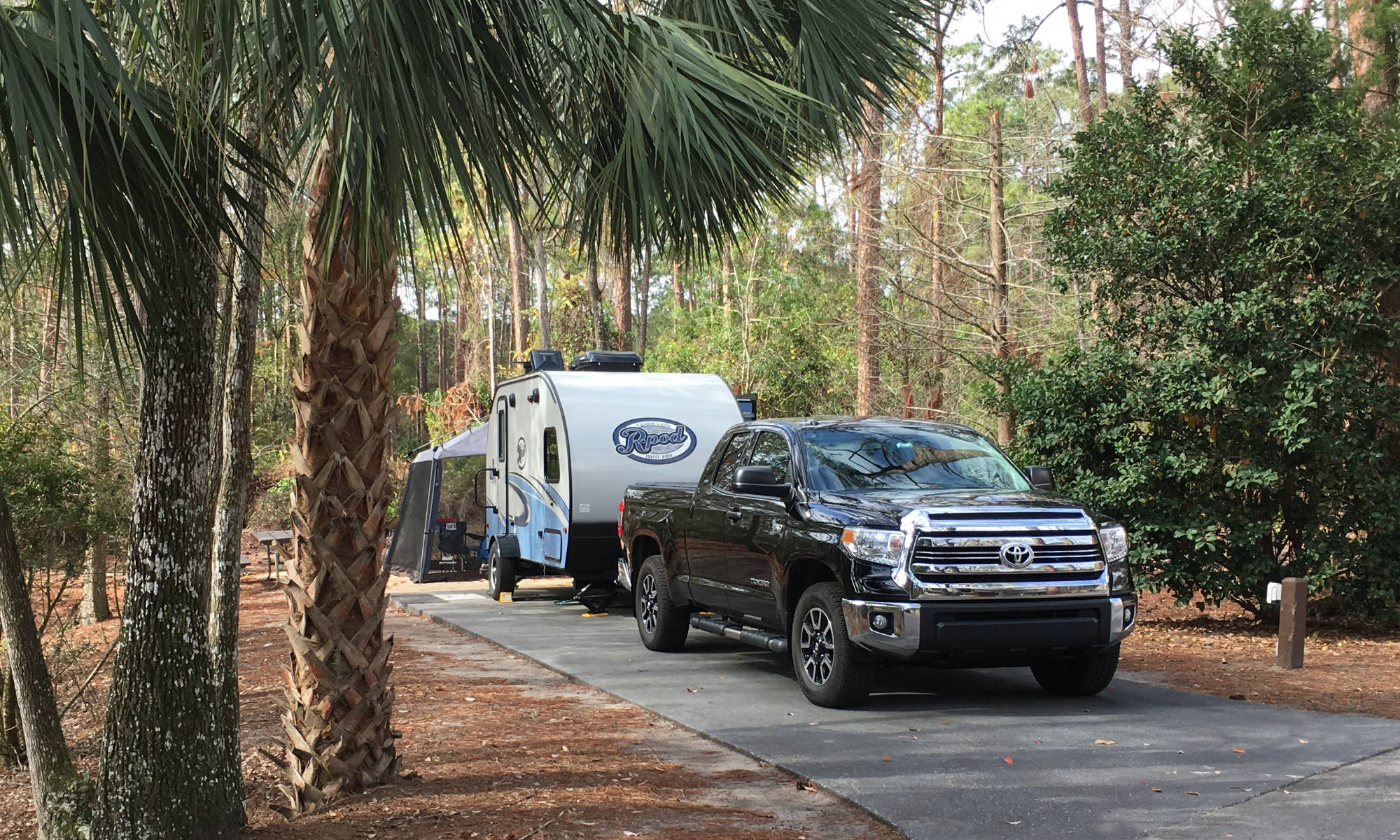In this blog, we’ll cover managing water and maintaining your RV’s wastewater tanks at a full hookup campsite. Camping at a full hookup campsite affords some opportunity to clean wastewater tanks to ensure they work properly when on the road. You don’t want to lose black tank capacity while traveling, and this process should help.
There are many ways to camp with an RV, from full hookups to various partial hookups campsites, to dry camping to complete off-grid camping. In this episode, we’ll look at water and wastewater tank management strategies at full hookup campsites. We have other content dealing with water and wastewater tank management at partial and no hookup campsites. Please check the video description for links to these other videos.
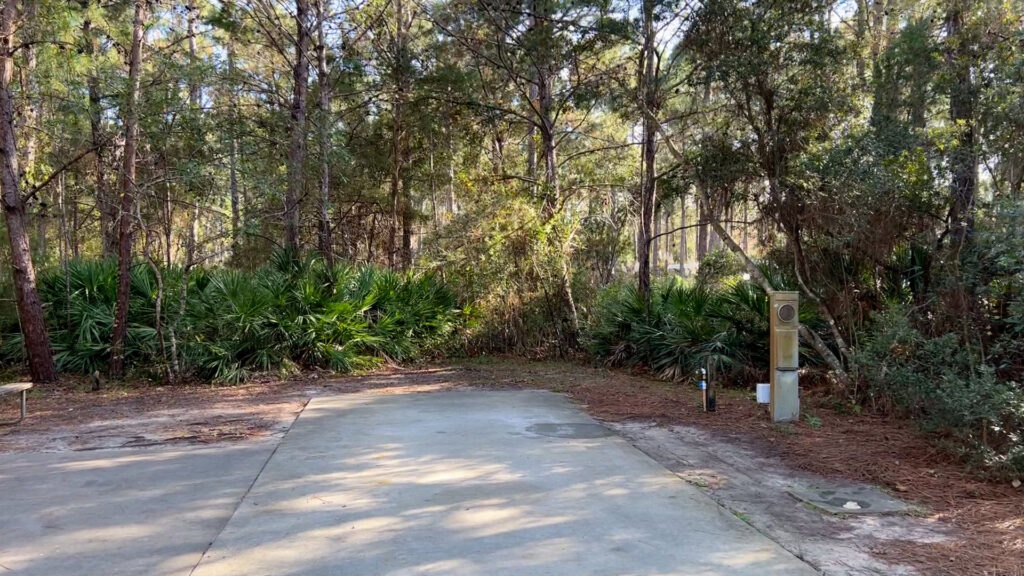
An RV usually has three types of tanks: a freshwater tank, and gray tank for non-toilet wastewater, and a black tank for the contents of the toilet.
Full Hookups
Full hookup camping means you can access city water, electrical service, and an in-ground sewer inlet at the campsite. This means you can use the city water connection for fresh water and don’t need to use your RV’s freshwater tank. You can plug your RV in for electrical service and keep a sewer outlet hose attached between your RV and the sewer inlet at the campsite. Therefore, you can dump your black and gray tanks anytime at the campsite without going to a public dump station. Full hookup campsites are commonly found at privately run campgrounds, at nationally branded campgrounds and at some state park campsites in the south and warmer climates.
First, let’s cover freshwater management at full hookup campsites. I almost always use the city water outlet at the campsite and some sort of pressure regulator and water filter to feed the city water line into the RV. This means it is essential to have a good water pressure regulator and water filter. I have seen campsites with very low and very high water pressure coming from the city water faucet. If the pressure is too high, it can damage your RV’s plumbing.
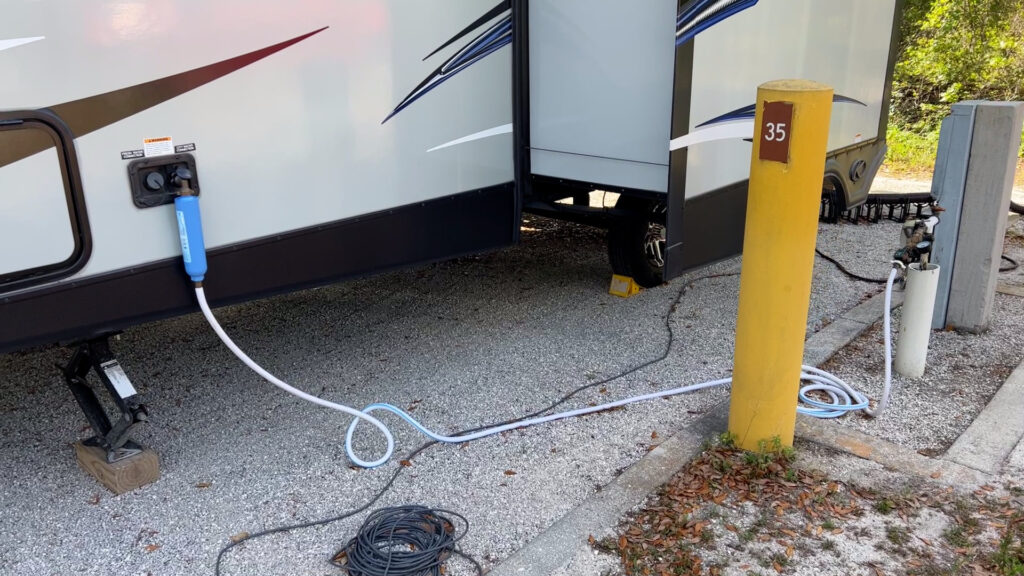
In general, I have few concerns with water consumption at a site that has a sewer inlet, mainly because I can empty my black and gray tanks anytime. I try not to be wasteful with water, but I am also not overly concerned about my water usage. I take typical-length RV showers and wash dishes – given the restraints of the hot water tank’s capacity and recovery times. I liken my RV to being an “apartment on wheels” when at full hookup campsites.
Wastewater Management
Next, let’s talk about wastewater tank management. With full hookups, there is little need to limit wastewater into the RV’s black and gray tanks, as they can be emptied anytime. When first establishing the campsite, I always hook up the sewer hose from my RV to the campsite sewer inlet and keep the gray and black tank valves closed when not dumping. This will keep odors from the campground sewer system from backing up into the hose and into the tanks.

Also, it is important to start with sufficient water in the black tank to help prevent the accumulation of waste solids. When starting out at a full hookup site, I put plenty of water in the black tank via the toilet – usually, 5-7 gallons, along with Happy Campers* tank treatment. However, if I am coming from a partial hookup site or haven’t flushed my black tank recently, I’ll first flush my black tank using the process detailed below.
Why do an extra tank flush when coming from a partial or no hookup site to a full hookup site? Usually, when you are on a longer trip, you will need to flush out the black tank thoroughly at some point. Coming to a full hookup site is ideal for this. Some people who mainly dry camp (meaning camping with no hookups) will occasionally book a full hookup site just to have this capability between extended dry camping stays. It provides a great way to maintain your wastewater tanks while on the road. You can take the needed time that you usually can’t at a public dump station.

To better facilitate the process I go through, I installed a cutoff valve on the toilet water line inside the RV to make things easier. I have a video on adding this cutoff valve and highly recommend watching it. The following process of cleaning out the black tank uses the toilet to fill the black tank with the tank’s exterior valve closed. It is vital that you understand that this can flood the RV if you are not being very careful.
For this process, I do not use the external black tank flush because its spray is located at the back of the tank and not where the solids build up, directly under the toilet.
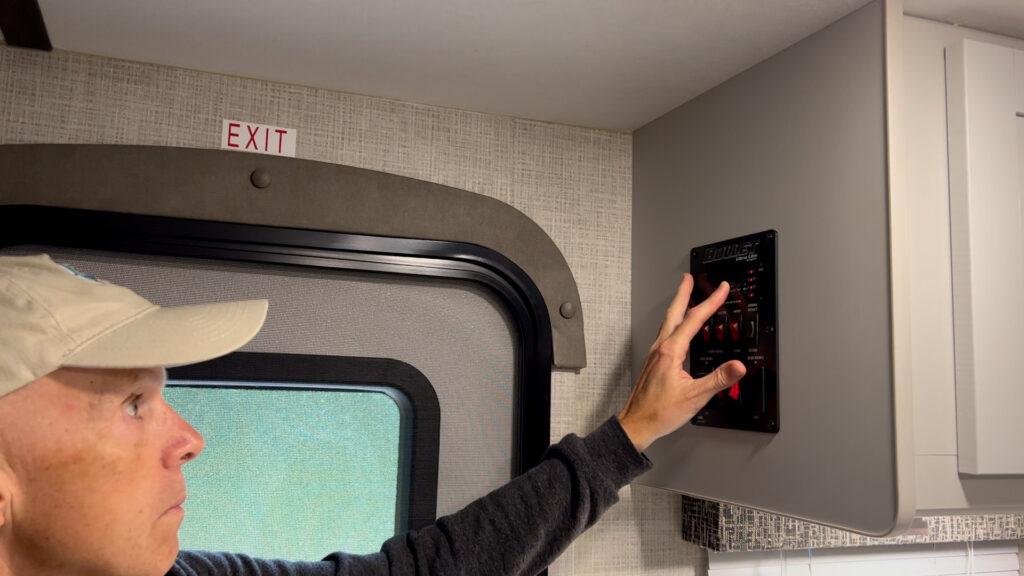
I never trust the indicator lights to tell me when the black tank is full. I now regularly use the old-school method of looking down into the black tank via the toilet to see the actual wastewater level in the tank. This is where a cutoff valve on the toilet line comes in handy. Ensure your internal ventilation fan in the bathroom is OFF when looking down into the tank, or the fan will pull the tank’s foul odor into the bathroom!
Here is the process I use when doing a black tank flush at a full hookup site:
First, get a headlight*, shut off the water to the toilet at the cutoff valve, and depress the toilet handle to look down into the tank to check the wastewater level.
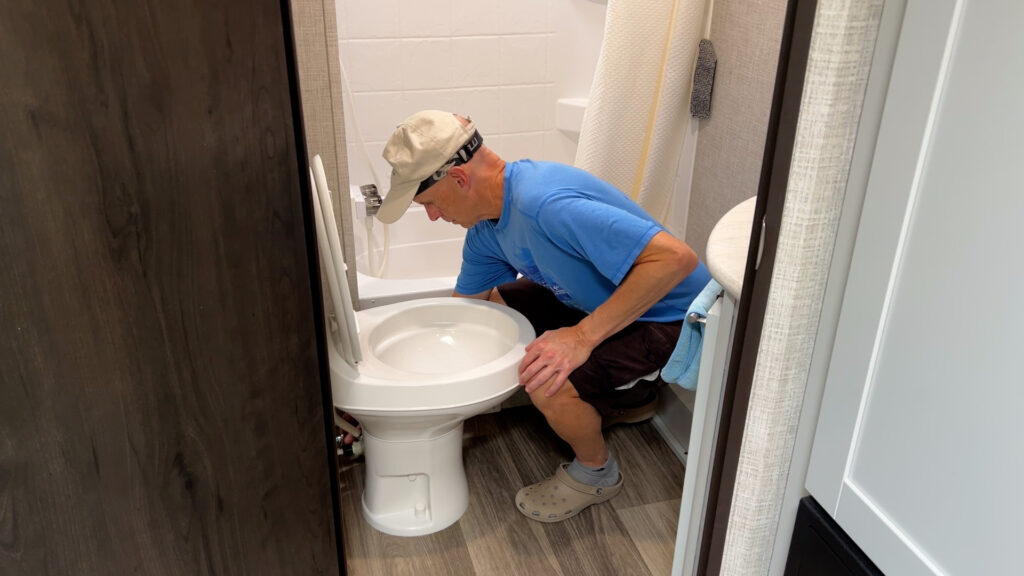
Most 30-gallon waste tanks are about 5-7″ deep. These tanks are long and wide but not very deep. On my 2020 Keystone Bullet 243BHS, my black tank is 54″ long by 28″ wide by 5″ deep. This means that roughly 1″ of water level equals about 6 gallons. So, for example, if you can visually see two inches of space between the wastewater level down in the tank and the top of the inside of the tank, you likely have about 12 gallons of free space in the tank. The tank is about 60% full. 1 – (12/30) = 60%. Often the tank’s indicator lights will show full or inaccurate measurements because of debris on the indicators in the tank. I have found the visual method works much better.

Next, if the tank is not already full, open the cutoff valve and use the toilet’s hand or foot handle to begin to fill the back tank with water via the toilet. This can take some time, depending on the water pressure and the amount of water already in the black tank. Every minute or so, close the cutoff valve to stop the water to the toilet and visually recheck the wastewater level in the tank.

Again, you must be very careful when filling the black tank with the exterior valve closed. You can FLOOD the RV if you overfill the black tank via the toilet. I have noticed when filling the tank via the toilet that the water going into the black tank will change pitch when it is getting full. I will verify the tank’s level visually often as it is getting closer to full.
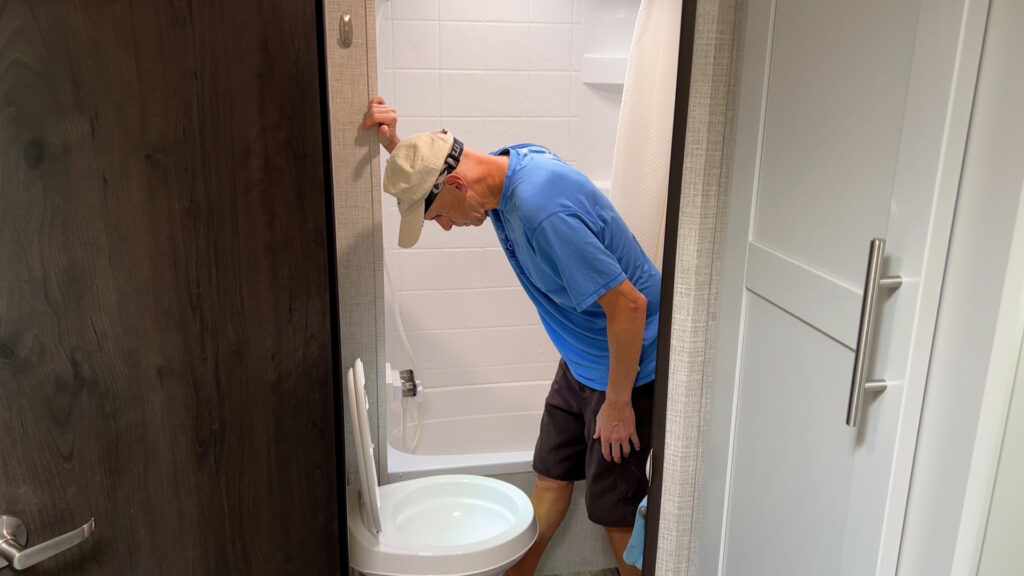
Next, once the black tank is full, go outside and open that valve to the black tank, and empty it. Doing this when the tank is full allows more water and pressure to flush out the tank’s contents.

Next, with the outside valve open to the black tank, go back inside the RV, fill the toilet bowl many times, and flush water into the tank. If you consider this, most of the solid waste in a black tank will accumulate where it lands, directly under the toilet. Filling up the toilet bowl with water and then flushing each bowl will force a gallon or more of water directly onto the landing zone. When using this method, I am usually surprised by the extra amount of dark matter that will be dislodged. I will flush as many as 12-15 bowls full while the black tank valve is open.
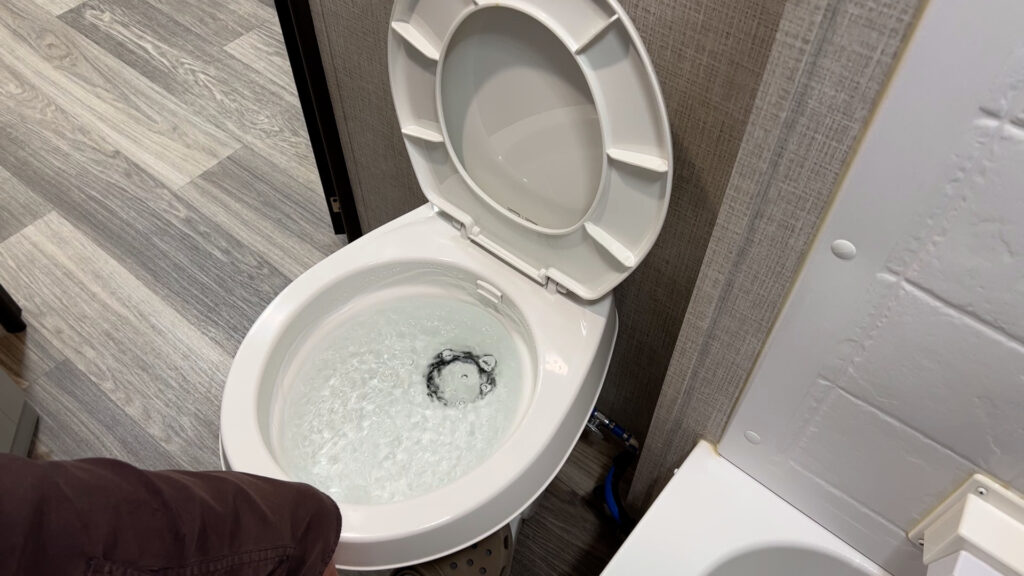
Next, stop flushing water and let the contents of the black tank empty for 5-10 minutes or until you can no longer hear water draining from the tank outside at the valve. You will have to go outside to verify this.
Next, after the black tank has fully emptied, shut the outside tank valve and go back inside and fill the tank again through the toilet. This will take 10-15 minutes, depending on your water pressure.
Before refilling the black tank the second time, I like to use a water meter* on the city water line to measure the amount of water the black tank can hold. It should, in theory, be 30 gallons (or whatever the tank’s capacity is) if the tank is truly empty. I do this to see how much of my tank is usable. This can be eye-opening. Thirty gallons is highly unlikely, but if I can only put in 20 or so gallons for a 30-gallon tank, it points to a solid waste accumulation problem shrinking the tank’s capacity.
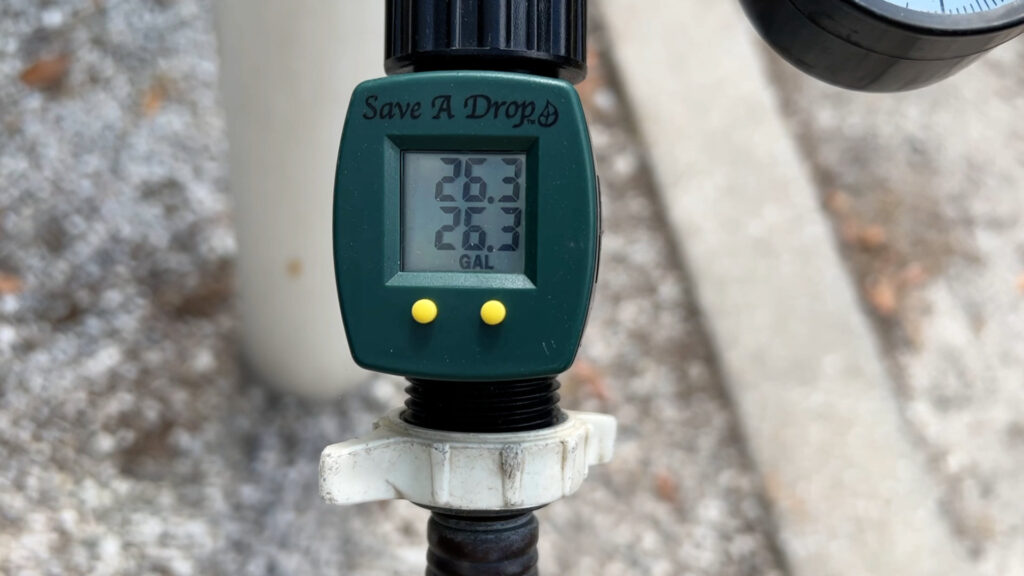
Next, after the tank is again visibly full (using the toilet’s cutoff valve and headlight), go out and take a look at your water meter and notate the number somewhere. Then open the black tank valve and empty the tank’s contents again.
Next, go inside, and again flush several toilet bowls full of water to clear out any residual debris.
Next, allow the black tank time to drain thoroughly. This would complete two full cycles of filling and flushing the black tank. For fun, I then check my indicator lights, and sometimes, the lights show an empty black tank!
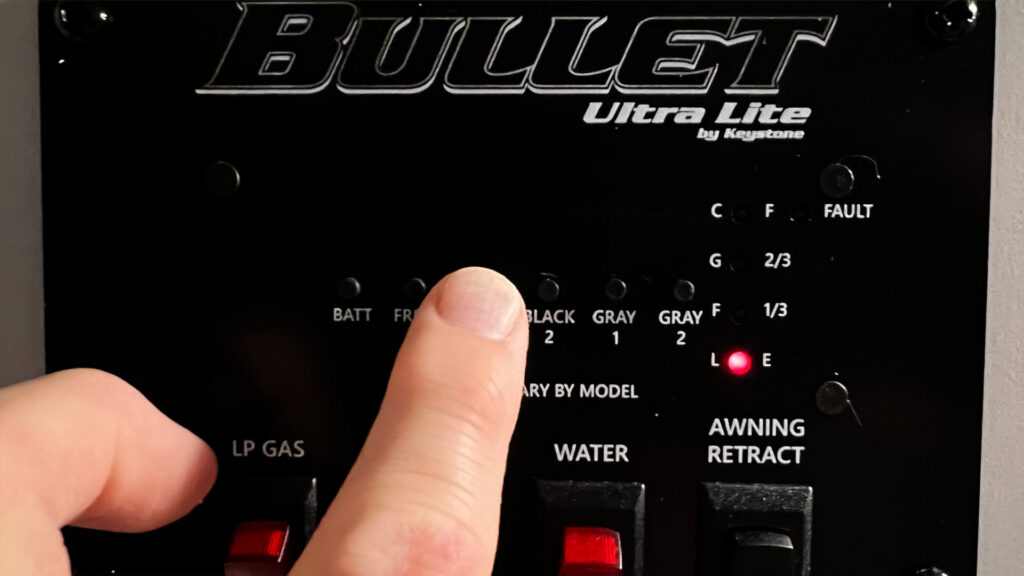
Next, close the black tank valve and open the gray tank to empty its contents. This will clean out the sewer hose.
Next, go inside and fill the black tank via the toilet with 5-7 gallons of water and some tank treatment. I recommend Happy Campers* tank treatment, having used it for many years with excellent results in terms of odor control.
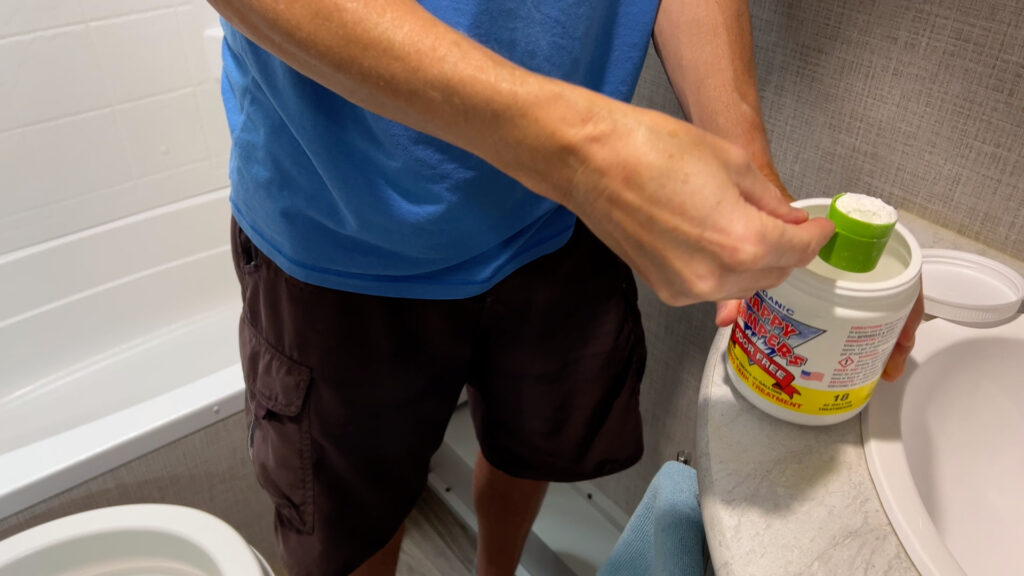
I have found this black tank maintenance process at full hookup sites to be very effective, yet it can be very time-consuming. I do this almost every time I move to a full hookup site from a non-full hookup campsite on longer trips. That’ll do it.
All the best in your camping endeavors!
As always, thanks to our fans who support our efforts by starting their shopping from our Amazon Storefront and by their generous financial support by using the THANKS feature located under each YouTube video ($ within the Heart icon). Your support is greatly appreciated!
FEATURED PRODUCTS*
Camco Sidewinder 10-Ft Camper/RV Sewer Hose Support: https://amzn.to/45zceER
Camco TastePURE Camper/RV Water Filter: https://amzn.to/3OEIsrH
Happy Campers RV Holding Tank Treatment – 18 treatments: https://amzn.to/45gFgcQ
Happy Campers RV Holding Tank Treatment – 64 treatments: https://amzn.to/45bGnue
Progressive Industries RV Surge Protector: https://amzn.to/3OFvZ73
RVGUARD RV Water Pressure Regulator Valve: https://amzn.to/45lTzwH
SharkBite 1/2 Inch Crimp Multi-Turn Straight Stop: https://amzn.to/3sfGG8N
Water Meter: https://amzn.to/47GhvMP
*Affiliate Link Disclosure: As an Amazon Associate I earn from qualifying purchases.
